Another bird who has always fascinated me is the frigatebird, especially the magnificent frigatebird. What a name! And what a fabulous red balloon the males use for mating! I’ve seen frigatebirds high in the sky before but have never seen the male with pouch fully inflated. However, as you remember from my previous post, it was mating season in the Galapagos, so my lack was soon remedied:
That’s a male frigatebird with his “gular pouch” fully inflated with air. He sits on the nest site he’s claimed and calls to females, hoping to lure one down to become his bride. Evidently, the red balloon attracts the females’ attention but the nest situation can be the deciding factor for choosing their mate. What do you think of this fellow’s choice of locale?
Once the female makes her choice, she joins the male on the nest, and he often drapes his wing over her. So sweet and romantic, or maybe he’s just hanging on to his babe.
My one disappointment? These frigatebirds were not magnificent, they were merely great. Magnificent frigatebirds have purple irridescence on their feathers while great frigatebirds have green as you can see on this handsome fellow:
Frigatebird moms are quite devoted, caring for their babies for eleven months, the longest parenthood for any bird species. For that reason, they only lay one egg every other breeding season . Here’s one mom with her pride and joy:
A less admirable trait of the frigatebird is–wait for it!–kleptoparasitism. Cool new word that our guide taught us! What does it mean? They steal stuff from other birds, especially the poor boobies. In the photo below, the frigatebird wanted the piece of nesting material the booby had found, but they will also steal food.
That’s why they are also sometimes called “pirate birds”. Tsk, tsk!
My father was in the Navy in World War II, and he told me that frigatebirds were often mistaken for airplanes when they were high in the sky. You can see in this photo why that might happen.
The frigatebirds have enormous wingspans–between 80 and 90 inches–especially compared to their body size, so they can stay in the air for as long as a week.
So while they might not be magnificent, these great frigatebirds were pretty darn interesting.

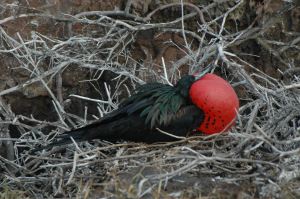
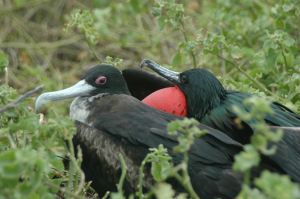
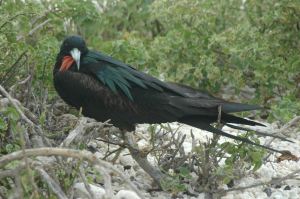
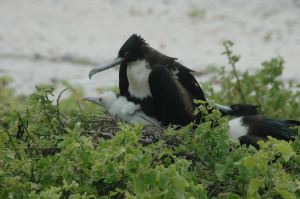

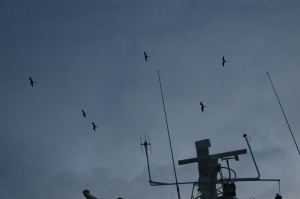
always wanted to visit the galapagos, what a great read thanks for sharing
http://sandbetweentoes.wordpress.com/